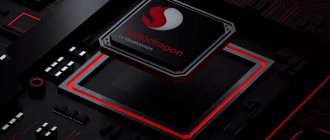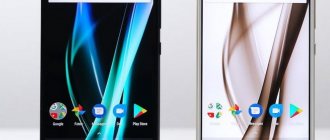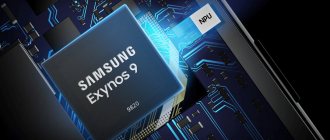The Snapdragon 855 is ready for production, and Qualcomm will indeed soon announce it as more of a "Mobile Platform" than a processor.
The 855 version promises to open the door to a new decade with fast 5G internet, artificial intelligence and mixed reality technologies such as AR (alternative reality) and VR (virtual reality). A flagship chipset with increased power paves the way for form factors beyond smartphones.
Why is the Snapdragon 855 mobile platform so important? Leaving aside Qualcomm's pride in the performance and energy efficiency of the new chip (not to mention 5G support), great importance is attached to the fact that the processor will be common in most mobile devices in 2019.
However, Qualcomm's ongoing conflict with Apple will likely make this processor a non-granta in the iPhone. However, Android phone makers will likely be lining up to get their hands on one of the flagships with the Snapdragon 855. We expect the chipset to be used in the Galaxy Note 10 in 2020. OnePlus and LG will undoubtedly also release smartphones with it, as will many other mobile device manufacturers, large and small.
Of course, not all of the hardware features will necessarily be fully implemented, but Qualcomm is offering its own new mobile platform. After everything we've seen so far, there may be a significant difference between what a Snapdragon can technically do and what a smartphone built on that Snapdragon will be capable of over time.
However, much of what was discussed by Qualcomm at the Snapdragon Summit 2020 conference was said about the “raw” device, but now we will talk about a device that is ready in all respects.
5G
Given expectations for the launch of the first commercial 5G network in the United States (most likely in 2020), it is not surprising that the Snapdragon 855 processor was designed more specifically for fifth-generation cellular communications. In fact, it seems that 5G will remain an option, regardless of whether it's included in a device.
The Snapdragon 855 will have an integrated X24 Cat 20 modem. This was originally a separate component. This modem (X24 Cat 20) enhances 4G LTE capabilities - albeit by simply managing 2 Gbps network bandwidth. The network is dependent and combined with 802.11ac, to achieve speeds of 10 Gbps, and the WPA3 security level. 802.11ay or mm Wave WiFi, as well as Bluetooth 5.0.
If the phone supports 5G, then it must also have a Snapdragon X50 modem installed. And although this is a separate part, Qualcomm still believes that the modem is part of the mobile platform. How useful this will be, and how common it will be in stores, will depend on how quickly 5G networks are deployed, and on the speeds they achieve at the earliest stage of interaction (with each other and with other networks). Certainly, while all the major US providers have 5G roadmaps, early coverage is likely to be the exception rather than the rule. Thus, it is clear why the presence of Snapdragon X24 on the board is so important: gigabit LTE is not available everywhere.
As for audio, Qualcomm has expanded its capabilities with its built-in True Wireless Stereo Plus system designed for completely wireless headphones. This should reduce the occurrence of delays between the left and right headphones and reduce power consumption.
The best smartphones based on Qualcomm Snapdragon 845, 855 series
Here we have included top flagships from well-known brands; cheap smartphones do not have such powerful processors.
Smartphone Samsung Galaxy S10+ 8/128GB
Processor: Qualcomm Snapdragon 855 RAM: 8 GB Main memory: 128 GB Screen size: 6.4 inches Main camera: 16 + 12 + 12 MP Front camera: 10 MP Battery: 4100 mAh
This year's flagship from the Korean brand, one of the best smartphones based on the Qualcomm Snapdragon 855 chip. The model received 8 GB of RAM and 128 GB of internal memory, but there are versions with larger capacity. This hardware is enough for any modern games and demanding applications.
The body is made of high-quality and durable materials; on the back there is a triple camera of 16 + 12 + 12 megapixels, it records 4K video and takes high-quality pictures in any lighting.
The model is equipped with a frameless 6.4-inch display with an aspect ratio of 19:9; it is a high-quality AMOLED with incredible color rendition. Galaxy S10+ is protected from water, you can even shoot underwater. A 4100 mAh battery is enough for a day of active use.
Pros:
— Screen — Performance — Cameras
Minuses:
- Price
Prices
Sony Xperia XZ3 4/64GB
Processor: Qualcomm Snapdragon 845 RAM: 4 GB Main memory: 64 GB Screen size: 6 inches Main camera: 19 MP Front camera: 13 MP Battery: 3300 mAh
Xperia XZ3 is a smartphone with a powerful Snapdragon 845 processor and a 6-inch OLED HDR display. The model has powerful stereo speakers with support for S-Force Front Surround technology; the sound comes from the screen itself and completely immerses you in the atmosphere of what is happening. Dynamic Vibration System analyzes what is happening on the screen and complements the picture with vibrations at the right moment.
The smartphone is made in Sony style, discreet design, thin body and recognizable logo. It is protected according to the IP65/68 standard, and is not afraid of water, and Corning Gorilla Glass 5 will protect the screen and body from scratches and breakage.
The 19 MP main camera takes cool photos of moving objects, records video in 4K and can shoot in slow-motion mode at 960 fps. Under moderate loads, the battery will remain alive until late in the evening.
Pros:
— Screen — Camera — Performance
Minuses:
— Slippery body
Prices
Productivity and Gaming
The new Snapdragon assumes stronger computing capabilities, this is also implied in relation to the processors included in its architecture - Qualcomm Kryo 485 and Adreno 640 graphics. The former promises a 45 percent increase in power compared to the previous one included in the Snapdragon 845. Despite the 8-core architecture Like the Snapdragon 845, Qualcomm has really changed the architecture significantly.
There is now one “Prime Core” to maximize performance, running at 2.84 GHz, and three “Performance Cores”, each running at 2.42 GHz. The remaining four “operational cores” Efficiency Cores operate at a lower frequency of 1.8GHz. Each of the eight cores has its own L2 cache, and they all share a common L3 cache. Overall, this gives the Snapdragon 855 more flexibility to deliver maximum power when needed.
As for the Adreno 640, it has a 20 percent increase in performance compared to the GPU included in the Snapdragon 845. The new graphics core supports formats such as H.265 and VP9, hardware accelerates decoding, and, in general, the chip is 7 times faster more energy efficient than before. Qualcomm also provided support for the second generation HDR algorithm to implement the HDR10+ and Dolby Vision standards.
Potentially more important for gamers will be frequency support. Therefore, 8K 360-degree video playback mode is provided along with Volumetric VR. Adreno 640 will be able to reproduce 4K HDR on the display of the smartphone itself and up to two external 4K HDR displays connected to it.
To maximize the performance potential of the Snapdragon 855, Qualcomm launched the Snapdragon Elite Gaming platform. An effective implementation of the definition for such a thing as kinematic color grading in HDR, with support for over a billion colors and filmic tone mapping, is the Vulkan 1.1 graphics library and PBR physical rendering.
This is far from what we've previously seen on mobile devices, but it could have a huge impact on gaming in the future. Its core has been modified for animation textures and rendering. But, game developers will be able to create psychologically-based rendering, which means Hollywood-level animation can be used to calculate the characteristics of various materials such as brick, fabric, or really anything from the periodic table, and then calculate how light will interact with these surfaces.
In theory, Qualcomm says you can do it all through software, just like before. However, then calculating color reflectance, micro surface textures, reflectivity and porosity will become extremely inefficient when it comes to power consumption, with decisions made at the chip level probably not requiring 40 fps. On the contrary, the Adreno 640 has hardware support for this, and developers will be able to dive into the workflow with the same ease as they would work through the Unity 4 game engine, which also supports PBR.
#10 – Xiaomi Pocophone F1
Price: 24,000 rubles
Our Xiaomi Pocophone F1 rating opens. This model was released at the end of August and is interesting not only for its filling, but also from an aesthetic point of view. The gadget is equipped with a 6.18-inch matrix with a resolution of 2246x1080 pixels. Memory configuration – 6 GB RAM and 64/128 GB internal memory. The rear camera is a combination of two sensors – 12 and 5 MP, the front camera has one 20 MP sensor. Battery capacity – 4000 mAh.
Since the Xiaomi Pocophone F1 is one of the newest flagships on the market, it is almost obvious that it has no weaknesses. Even if you are as objective as possible, you can only find fault with the gadget for the lack of an NFC module and protection according to the IP 68 standard. In all other respects, the smartphone is excellent. I would also like to say something about the display. The matrix is calibrated in the best way, so the owner of Xiaomi Pocophone F1 will not have problems with viewing angles, image detail, or other important parameters.
Xiaomi Pocophone F1
Artificial intelligence
AI in mobile is a big deal and there are many reasons for this. Undoubtedly, this performance will mean that the presence of AI core support in the device will make data processing faster than sending it for processing to the cloud and transmitting the results back. However, this is also a strong argument in the context of security; it has become possible to make it possible to store information on the majority of users on their phone or tablet.
For the fourth generation processor from Qualcomm Snapdragon 855, the AI core is the debut. This combines the Adreno GPU and Kryo 485 CPU with the new Hexagon 690 chipset processor, which is three times the AI performance of the old Snapdragon 845.
The Hexagon 690 will give Qualcomm four vector extensions (HVX) and double the vector processing of its predecessors, along with four scalar threads and a new Hexagon Tensor Accelerator (HTA) design. “We were asked to add more of these capabilities to the device,” explains Francisco Cheng, Snapdragon technology evangelist, “with Hexagon being the most energy-efficient core today.”
It also has native support for things like Google Assistant, Baidu's DuerOS and other voice AI platforms. This includes dedicated AI acceleration for echo/noise cancellation, which increases the likelihood of being heard across a room or in loud background noise. In fact, the Snapdragon 855 can perform noise reduction with just one microphone, unlike traditional systems that require 2 or more microphones.
No. 3 – Meizu 16th
Price: 38,000 rubles
Third place in our list of the best smartphones with a Qualcomm Snapdragon 845 processor goes to Meizu 16, dedicated to the company’s 16th anniversary. The gadget has a stylish and elegant design without fancy elements, even without bangs. Display diagonal – 6 inches, resolution – 2160x1080 pixels. The amount of RAM is 6/8 GB, the amount of internal memory is 64/128 GB. Battery capacity – 3010 mAh. The main camera is dual – 12+20 MP, front – 20 MP.
Meizu 16th is a very high-quality smartphone without significant disadvantages. The only thing that may confuse me a little is the lack of an NFC module, but otherwise everything is fine. The display is made using Super-AMOLED technology, while the matrix is calibrated almost perfectly, so the owner will always enjoy the image with the maximum level of detail. There will be enough filling to run demanding games over the next year or two. Although the cameras are not capable of producing professional images, their capabilities will be sufficient for the average user.
Meizu 16th
Camera and Computational Photography
Smartphone buyers pay attention to camera functionality, so it's no surprise that many of the Snapdragon 855's improvements are centered around improved image and video capture. At the heart of this is the new Spectra 380 ISP, which features the world's first computer vision (CV) ISP and also features CV-ISP for more efficient computational photography.
The Spectra 380 can handle things like color channels, noise reduction, autofocus, autoexposure, and more. Thus, the computer vision channel collects color information together with HDR10+ in the video and combines them. Previously, this was the responsibility of the CPU/GPU/Hexagon, but providing these processes with the new Spectra has certain advantages.
For starters, it provides four times the energy savings of the old method while increasing performance. There is also a twofold increase in energy savings when tracking a body in six degrees of freedom (6DoF) and a fourfold reduction in energy consumption when detecting and tracking an object. The Snapdragon 855 can record 4K video at 60fps with HDR while using 3 times less power than the old 845 when capturing 4K video at 30fps. Qualcomm can now support things like depth sensing at 60 fps and portrait mode not only for frames, but also for 4K video. This can mean defocusing the background in the video, as well as removing it and replacing it with something else.
Hardware acceleration for HEIF file format encoding and decoding has also returned. Until now, the biggest move towards HEIF has been made by Apple in the latest iPhone models, the format offers an advantage as it provides half the compression of jpeg. However, this is only the tip of what HEIF can actually do.
For example, HEIF encoding can store HDR color information, computer vision data, a depth map created when shooting, raw data (RAW), or even flash and animated photos, all in one file. On devices with multiple cameras, like the LG V40, which has a wide-angle, regular and telephoto lenses, each can capture an image simultaneously, and then all three shots will be combined into one HEIF. That is, instead of storing multiple images, one HEIF file will store them all.
Of course, the device receiving HEIF files will need to decompress them, however, this format is built into Android 9 Pie. Services like Google Photos will likely also quickly be able to embrace the potential of the format. Qualcomm has mocked up what the interface for navigating HEIF files might look like, although it will be up to individual device and service manufacturers to decide how to present the additional wealth of data stored in each file.
Top 7 cheapest smartphones with Snapdragon 855 Plus from AliExpress
Reward accrued
This material was written by a site visitor and was compensated for.
Last year, flagship smartphones based on the Android operating system were mostly powered by the Snapdragon 845 mobile processor. For the first-generation ASUS ROG Phone gaming solution, a special version of the single-chip system with increased frequencies of processor cores and graphics accelerator was presented.
This year, most flagships are equipped with the Snapdragon 855 chip. For gaming solutions, Qualcomm has again released a processor with increased CPU and GPU frequencies. But if last year there was no special emphasis on this, this time the “accelerated” single-chip system even received a separate name - Snapdragon 855 Plus. It debuted in the gaming smartphone ASUS ROG Phone II, and a few days later it appeared in its, one might say, competitor Black Shark 2 Pro. But over time, OEM companies began to use this processor in non-gaming smartphones.
announcements and advertising
2080 Super Gigabyte Gaming OC for 60 rubles.
Compeo.ru - the right comp store without any tricks
RTX 2060 becomes cheaper before the arrival of 3xxx
Ryzen 4000
series included in computers already in Citylink
The price of MSI RTX 2070 has collapsed after the announcement of RTX 3xxx
Core i9 10 series is half the price of the same 9 series
The price of memory has been halved in Regard - it’s more expensive everywhere
The product is manufactured in accordance with the standards of 7-nanometer technology. It includes three blocks of cores. The “large” core has a clock speed of 2.96 GHz. Three cores with a frequency of 1.8 GHz are responsible for light computing. The middle cluster is represented by a trio of processor cores, the operating frequency of which is 2.42 GHz. Adreno 640 accelerator frequency is 0.7 GHz. In this article, we will talk about the seven cheapest smartphones based on the Snapdragon 855 Plus mobile processor that you can buy on AliExpress.
Let's start with a new product that was presented a few days ago. It is called vivo iQOO Neo 855 Racing Edition. A company from China this year has succeeded in releasing relatively inexpensive smartphones on flagship hardware. This model is one of such devices. Regardless of the configuration, the new product carries 128 GB of RAM on board. On AliExpress you can buy a version with 8 GB of RAM for $430, and with 12 GB of RAM for $440. Flash memory type – UFS 3.0.
Alas, the presence of even the most powerful mobile processor does not always allow one to call a smartphone a flagship. vivo iQOO Neo 855 Racing Edition is a prime example of this. The model cannot offer a high-quality camera, wireless charging, water protection, or any unusual features, not counting the proprietary software mode for games.
The main camera in the smartphone has three modules – 12 MP (universal), 8 MP (wide-angle) and 2 MP (additional). The latter is used for depth analysis and background blur. The selfie camera has a resolution of 16 MP. It is located in a drop-shaped cutout on the front side. The screen of vivo iQOO Neo 855 Racing Edition is characterized by a size of 6.38 inches, a resolution of 1080 x 2340 pixels and HDR10 support. The capacity of the included battery is 4500 mAh.
The model has acquired support for 33-watt wired charging, a standard audio output and a USB-C port. The camera, which is responsible for scanning fingerprints, is installed under the display. The software basis is Funtouch 9 firmware, which is based on Android 9 OS.
To product >>>>>> 8/128 GB
To product >>>>>> 12/128 GB
A few months before the announcement of vivo iQOO Neo 855 Racing Edition, the Chinese company presented another model based on the Snapdragon 855 Plus chip under the same brand. The smartphone is called iQOO Pro. The August new version with 8 GB of RAM and 128 GB of non-volatile memory costs $463. For an additional 4 GB of RAM you need to pay about $55 more.
iQOO Pro looks practically no different from iQOO Neo 855 Racing Edition. The screen diagonal has been increased to 6.41 inches, but there is no support for extended dynamic range. The main camera retains the same configuration in general and the 2-megapixel image sensor in particular. The resolution of the wide-angle module is 13 MP instead of 8 MP, and the universal one is 48 MP instead of 12 MP. Another difference is support for recording video in 4K at 60 fps and in HD at 1920 fps. The selfie camera is based on a 12 MP sensor.
iQOO Pro has an NFC chip and supports 44W wireless charging. The capacity of the built-in battery is also 4500 mAh. All interfaces, including a standard audio output for headphones, are also in place.
To product >>>>>>
In addition to vivo, other companies that are part of the BBK Electronics corporation have also succeeded in producing smartphones based on the Snapdragon 855 Plus. For example, OnePlus 7T appeared in October. Along with the regular model, the Pro version was presented, but it costs one and a half times more, but offers essentially the same thing. For this reason, OnePlus 7T looks like a more attractive solution.
The flagship is equipped with a Fluid AMOLED Full HD+ screen with 100% coverage of the DCI-P3 and HDR10+ color space. The display diagonal is 6.55”. One of the features of the smartphone is the refresh rate of 90 Hz. At the top there is a drop-shaped cutout in which a 16 MP selfie camera is installed.
The back panel of the smartphone is made of Gorilla Glass 5 and contains a large circular area with three lenses, and the fingerprint sensor is located under the display. The main 48 megapixel module received an optical stabilization system. The wide-angle module has a resolution of 16 megapixels and can record video right out of the box. The 12-megapixel telephoto module received 51 mm optics. The flagship can record video in UHD at 60fps.
The capacity of the non-removable battery is 3800 mAh. The OnePlus 7T boasts stereo speakers, but the smartphone lacks a headphone jack. For $460, the flagship on AliExpress is available in a version with 8 GB of RAM and 128 GB of storage. The version with 256 GB of ROM with the same amount of RAM costs $40 more.
To product >>>>>
Another model from BBK Electronics is Realme X2 Pro. It was presented in mid-autumn. The smartphone stands out not only in its hardware, but also in appearance. We are talking primarily about the strange location of the logo, which is located on the rear panel and shifted to the right side. The main camera is installed next to the logo in a vertical orientation. It combines four modules with a resolution from 2 megapixels to 64 megapixels. The 8-megapixel wide lens has an aperture of f/2.2, and the 13-megapixel telephoto lens allows you to take pictures with a 2x optical zoom. The smartphone can record video in 4K at 60fps.
The front panel has a display with a drop-shaped cutout. It houses a front camera built on a 16-megapixel matrix. The screen itself is based on an OLED panel with a refresh rate of 90 Hz, HDR10+ support and 100% DCI-P3 coverage. The maximum brightness is 1000 nits. The display has a 6.5" diagonal and 1080p resolution on the narrow side. Proportions – 20 to 9.
Realme X2 Pro packs a 4000 battery and supports 50W fast charging that can fully charge the battery in 35 minutes. The smartphone has stereo speakers, Mini-Jack and NFC. The model runs on Android 9 OS, and an update to Android 10 will be released in the near future. On AliExpress, the phone can be purchased in three versions: 6/64 GB, 8/128 GB and 12/256 GB. Depending on the amount of memory on board, the cost of Realme X2 Pro ranges from $380 to $530.
To product >>>>> 6/64 and 8/128 GB, 12/256 GB
Realme is a sub-brand of OPPO. The Chinese manufacturer, under its own brand, also released a smartphone based on the Snapdragon 855 Plus chip. The device is called OPPO Reno Ace. The model is very similar to Realme X2 Pro. It also received an FHD+ screen with a built-in fingerprint sensor and a frequency of 90 Hz, Android 9 OS, stereo speakers, NFC and a 16-megapixel front camera.
The main camera also has a 2-megapixel depth sensor, an 8-megapixel wide-angle module and a 13-megapixel telephoto lens with 2x optical zoom. But the resolution of the universal module is 48 megapixels, not 64 megapixels. Another difference is the fast charging power. It is equal to 65 W. The 4000 mAh battery charges from zero to 100% in half an hour.
OPPO Reno Ace can be purchased for $455 in a version with 8 GB of RAM and 128 GB storage. The version with double the amount of permanent storage costs $70 more, and for 12 GB of RAM and 256 GB of flash memory you will have to pay another $120.
To product >>>>>
Naturally, when it comes to the cheapest smartphones in any category, it is impossible to do without Xiaomi devices. In this case we will talk about Xiaomi Redmi K20 Pro Premium. The smartphone offers users 12 GB of RAM paired with 512 GB of ROM for only $430.
The special edition was released three months after the regular model was released. It retained all the main features of the latter, and the only updates were the Snapdragon 855 Plus processor, which replaced the Snapdragon 855 chip, as well as increased amounts of RAM/ROM.
Redmi K20 Pro Premium is equipped with an OLED display with an integrated biometric sensor. The diagonal of the matrix is 6.39 inches and the resolution is 2340 x 1080 pixels. The retractable front camera received a 20 megapixel sensor. The main camera has a universal 48-megapixel module, a 13-megapixel wide-angle and an 8-megapixel telephoto lens, which allows you to take photos and record videos with a 2x zoom without losing quality in relation to the main module.
The Redmi K20 Pro Premium has an NFC chip, and the model runs on Android 10 OS. The capacity of the built-in battery is 4000 mAh. Chinese developers left the smartphone without support for wireless charging. The device does not have a microSD slot. But the headphone jack has not gone away.
To product >>>>>
Let's complete the selection with a smartphone that won the Swan Award 2020 for Best Appearance. It's called the Meizu 16s Pro and is one of the few phones in 2020 that doesn't have a waterdrop notch, notch, pop-up camera or display hole.
On the front panel of the smartphone, above and below the OLED screen, there are two identical indents. The lower field is empty, and at the top there is a set of sensors, a speaker and a 20-megapixel front camera. The display has a diagonal of 6.2 inches and FHD+ resolution. The Meizu 16s Pro body is made of metal and glass. The fingerprint scanner is installed under the OLED screen, while on the rear panel there is only a flash with a triple main camera. It includes a 48-megapixel main module and a 20-megapixel telephoto lens, accompanied by a 16-megapixel wide-angle module. Videos can be recorded in 4K at 60 fps.
Meizu 16s Pro has an NFC module, a USB-C port and Android 9 OS with proprietary Flyme 8 software. The non-removable battery capacity is 3600 mAh. The Chinese company left the smartphone without a wired headphone jack and a slot for microSD. On AliExpress the cost of the 6/128 GB version is $460. You will have to pay approximately $500 for the 8/128 GB modification, and a configuration with a 256 GB drive will cost $580.
To product >>>>>
Safety
The main feature of the security technology improvements in the Snapdragon 855 is the Qualcomm 3D Sonic Sensor. Announced yesterday, it's the company's latest fingerprint scanner, which uses ultrasound to build a 3D map of the surface of your fingertip. What makes it particularly special is that it can be integrated under a display. We've seen in-display fingerprint scanning before, but Qualcomm says its system is robust and secure. Because it is based on ultrasonic mapping of the ridges and whorls of a fingerprint, it can scan through dirt and grease. While optical scanning builds a 2D image, the 3D Sonic Sensor more efficiently collects a texture map of the fingertip, which is safer.
The best smartphones based on Qualcomm Snapdragon 660, 675 series
Here we have included mid-range smartphones, such as their processors. They are affordable for most buyers, have good cameras and can handle modern games at medium-high graphics settings.
Smartphone Samsung Galaxy A70
Processor: Qualcomm Snapdragon 675 RAM: 6 GB Main memory: 128 GB Screen size: 6.7 inches Main camera: 32 + 5 + 8 MP Front camera: 32 MP Battery: 4500 mAh
The model was presented recently; the Galaxy A70 was equipped with a 6.7-inch Super AMOLED display with an aspect ratio of 20:9. The display has a built-in fingerprint scanner and a face unlock feature. The built-in Dolby Atmos speakers are responsible for the sound; the sound is high-quality and loud.
The smartphone runs on a Qualcomm Snapdragon 675 processor, Adreno 612 is installed as the graphics core. The amount of RAM is 6 GB. The built-in memory can be expanded with a card up to 512 GB. The main camera received three modules: 32, 5, 8 megapixels. It can record 4K video and shoot in wide-angle format.
The body of the smartphone is made of durable plastic; it looks best in black, which shimmers into an “oil slick.” There is an NFC module. The 4500 mAh battery can withstand a day of active use.
Pros:
— Screen — Performance — Battery — Camera
Minuses:
— Large dimensions — Glass and body are easily scratched
Prices
Xiaomi Redmi Note 7 4/64GB
Processor: Qualcomm Snapdragon 660 RAM: 4 GB Main memory: 64 GB Screen size: 6.3 inches Main camera: 48 + 5 MP Front camera: 13 MP Battery: 4000 mAh
The first smartphone of the Redmi brand, it received special attention. The smartphone fits comfortably in the hand and does not cause discomfort; the display aspect ratio is 19.5:9. The display itself has a diagonal of 6.3 inches and has a resolution of 2340x1080 pixels. The glass is resistant to scratches and falls.
Redmi Note 7 is powered by Qualcomm Snapdragon 660 processor and has 4GB of RAM. The built-in memory of 64 GB can be expanded with a card up to 256 GB. The main camera received a 48 megapixel Samsung GM1 main module, its aperture is F/1.8. The 5 MP auxiliary module is designed for scene depth analysis.
The 13 megapixel front camera is controlled by artificial intelligence, and there are built-in technologies to improve the quality of pictures. There is a face unlock function, and there is a standard fingerprint scanner on the back. The 4000 mAh battery can withstand a day of active use, and the USB-C port is used for charging.
Pros:
— Hardware — Cameras — Screen
Minuses:
— Protruding chamber — Slippery body
Prices
List of all phones with Snapdragon 855
Xiaomi:
- Redmi K20 Pro
- Xiaomi Mi 9, Mi 9 Explorer
- Black Shark 2
- Mi Mix 3 5G
Other:
- Samsung: Galaxy Galaxy S10, S10+, S10e, S10 5G, Fold (in Russia, these phones are sold with Exynos 9820 processor)
- Meizu 16s
- Asus Zenfone 6
- OnePus 7, 7 Pro, 7 Pro 5G
- Sony Xperia 1
- Oppo Reno 10x zoom, Reno 5G
- LGG8 ThinQ, G8s ThinQ, V40 ThinQ
- Lenovo Z6 Pro, Z6 Pro 5G
- Vivo iQOO
- ZTE Axon 10 Pro, Axon 10 Pro 5G
- Energizer Power Max P8100S
Connectivity
The entire talk during the summit was focused on 5G networks, and naturally, everyone expects the new chipset to come with an integrated 5G solution. However, the Snapdragon 855 comes with an X24 LTE Cat.20 modem with speeds that can reach a maximum of 2Gbps. If smartphone manufacturers want to offer 5G connectivity, they need to add a Snapdragon X50 modem along with a mmWave module.
The Snapdragon 845 comes with an X20 LTE Cat.18 modem with speeds that can reach up to 1.2 Gbps. Obviously, the 855th “dragon” will be faster.
Graphics capabilities
In its new chipset, Qualcomm has upgraded the GPU to Adreno 640, which the company says helps improve performance by 20%. The GPU also supports 4K HDR video recording with a 30% reduction in power consumption, HDR10+ playback at 120fps, and 8K playback.
The Snapdragon 845, on the other hand, is equipped with the Adreno 630 GPU, which offers 30% faster graphics and 30% better power efficiency compared to the 835 model.











